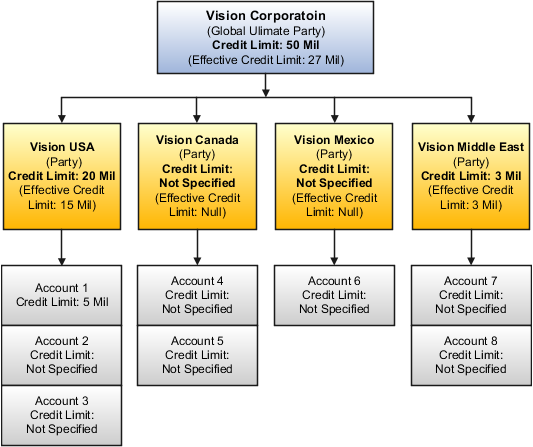How the Credit Limit is Derived in a Party Hierarchy
When a credit check is initiated, the credit checking process ordinarily looks for a credit limit value in the customer account profile and, if no value is found, in the customer profile.
Once a credit limit value is found, credit checking proceeds to verify the customer's credit for the given credit authorization request.
You can also define a party-level hierarchy for a customer. If you use a party-level hierarchy, then the credit checking process uses the credit definitions in the party hierarchy to determine the customer credit limit.
The party-level hierarchy is set up using the Manage Hierarchies setup task. To use a particular type of hierarchy in Credit Management, you specify the hierarchy type using the Hierarchy Type for Credit Management profile option. The default value for this profile option is None, meaning no customer hierarchy is used by Credit Management unless you assign one. If you want to use a party-level hierarchy, set the Hierarchy Type for Credit Management profile option value to the correct hierarchy type as defined in the Manage Hierarchies setup task.
If a party-level hierarchy is defined for a customer, then the credit checking process first derives a credit limit from the parent party in the hierarchy, and then considers the available credit for each child party in the hierarchy to find the actual credit limit.
For example, consider the following party-level hierarchy for Vision Corporation:

The party profile credit limit defines the total credit amount that all children have available. In this example, Vision Corporation has a credit limit of $50 million. The actual credit limit for a given party is derived by considering both the defined credit limits and the children that don't have a credit limit defined.
Vision USA has a credit limit of $20 million available to its three accounts. Account 1 has a specified credit limit of $5 million, so Account 2 and Account 3 together can use up to $15 million.
Vision Middle East has a credit limit of $3 million available to its two accounts. Account 7 and Account 8 together can make use of this $3 million.
Vision Canada and Vision Mexico don't have credit limits defined, so effectively these parties can make use of the undefined $27 million in credit.
If, for example, Vision Canada Account 4 submits an order for $2.5 million and Vision Mexico Account 6 submits an order for $3.5 million, then after these orders are authorized, the remaining credit available to Vision Canada and Vision Mexico is $21 million.